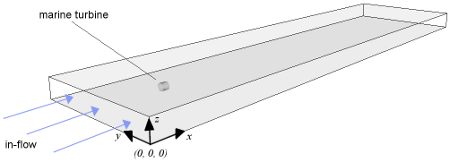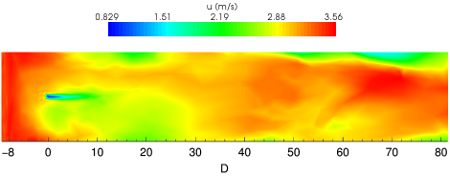 |
|
Research :: tidal marine modelling
Assessing areas with strong tidal flow for energy yields is important for tidal marine turbine farm development, especially given the engineering challenges present whilst working in such extreme environments. Moreover, given the difference in turbulence levels and Reynolds numbers of the flow, rules regarding wind turbine spacing in wind farms cannot be assumed valid. Therefore, the use of CFD simulation in assessing tidal marine turbine farm sites and wake interactions with downstream turbines is vital. With this in mind, the Heriot-Watt turbine model can also be used to simulate tidal marine turbines as well in their marine environment. One three-dimensional example modelled was Marine Current Turbine Ltd's Seaflow 300kW prototype, in a study to investigating the effect of seabed roughness and bottom drag on wake length and turbine performance. This was set 40m above the bottom of tidal channel of dimensions (1km x 400m x 80m). 
Current research in this area involves investigating the interplay between seabed topography, turbulent flow and tidal farm layout for selected tidal sites around Scotland. Tidal flow at large scales will be compared with depth integrated models such as Mike21; at finer levels of detail, simulation results will be compared with ADCP data in specific areas. Eventually, as with our wind farm modelling, the goal is to develop a tool that can be used within research and industry to explore and evaluate tidal farm sites as viable energy resources, and to further understanding of the role of turbulence in turbine performance and wake structure, and the potential affects of tidal turbine farms on the marine environment. Through understanding these mechanisms, we aim to promote tidal energy as a viable alternative to non-renewable sources. | |
 | |
| © Copyright 2010 Heriot-Watt University | Disclaimer | • | Freedom of Information |

